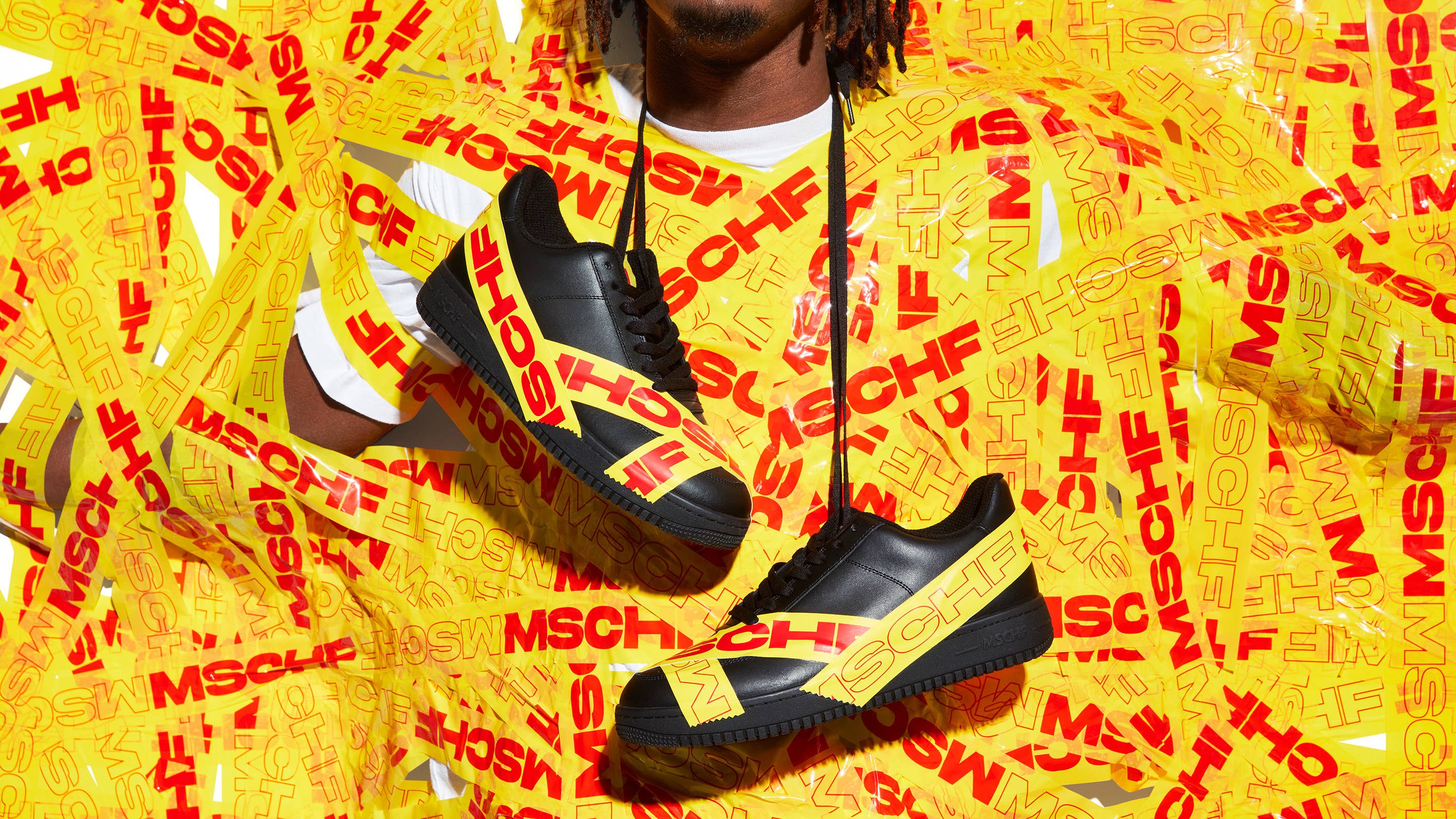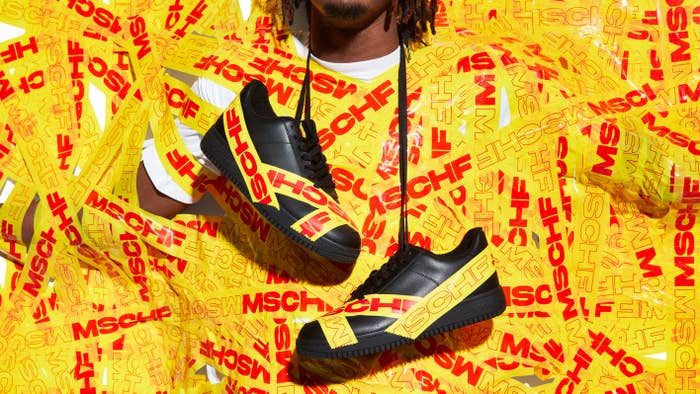
How certain are the designers at MSCHF, the trolling Brooklyn art collective whose previous footwear includes the Jesus Shoe custom and the hysteria-inducing Satan Shoe sequel, that their latest sneaker will not earn them another lawsuit from Nike?
MSCHF chief creative officer Kevin Wiesner recalls that they’d internally cleared the Satan Shoe collaboration with Lil Nas X as “1,000 percent legal” before its release. Nike promptly filed a claim against MSCHF over that one, accusing them of trademark infringement and dilution. Still he is no less confident about its latest shoe, which is definitely not an all-black Air Force 1 even though (Nike lawyers, don’t read this part) it looks rather like an all-black Air Force 1.
“I think you just gotta say it again,” Wiesner says, suggesting they reiterate the estimate of 1,000 percent this time.
“Would you like me to say it again on record?” offers MSCHF co-founder Daniel Greenberg, carefully navigating his response.
After a couple of starts, stops, and half-sentences they arrive again at complete certainty that the new shoe will not land them back in court. But they add, of course, there’s also nothing wrong with Nike deciding to sue them.
The sneaker, called the Tap3 (as in “tape”) riffs on the meme status of the all-black Air Force 1. It’s not a Nike, so it has no Nike logos, and instead features a TPU tape material in yellow wrapping its upper in the places one might expect to see Swooshes. It’s also not a custom take on an existing pair of Nikes, unlike MSCHF’s other shoes.
The Tap3 shoe releases on March 21 at 11 a.m. EST as the first product from the MSCHF Sneakers app, a dedicated platform that will host regular sneaker drops. There are many more planned to roll out on a monthly basis—a rapper collaboration, a warped mutation of a classic model, and some impossible boots that the brand isn’t ready to unveil yet. The Tap3 is the tamest among them. Pricing across the app will be standardized at $220 for sneakers and $295 for boots.
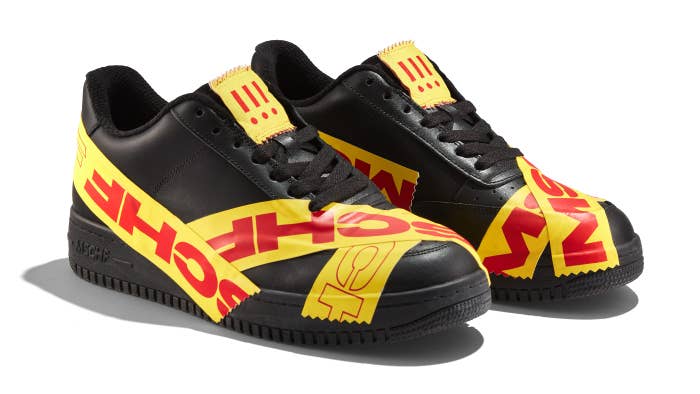
Shoes are only a small part of what MSCHF does. The somewhat nebulous creative studio has weekly releases that include stunty art and fashion drops designed to provoke. There is one centered on an unnamed famous mouse that references Disney’s fierce protection of the Mickey Mouse intellectual property. Several MSCHF staff are banned for life from Venmo and Greenberg says a major cell carrier still won’t let them send text messages over its network after they manipulated those services to promote their projects. The provocative approach—the occasional confusion, controversy, and legal action—is less a side effect and more a central goal of the work.
The lawsuit over the Satan Shoe in 2021 puts them in the company of independent designers like John Geiger and Warren Lotas who have been sued over shoes that draw too much from Nike. MSCHF sneakers to date are not quite the same as those examples—its shoes have been more straightforward customs of legitimate Nikes that do not significantly alter the logos. But its designers do empathize with anyone making bootleg Dunks or Air Forces that find themselves in a legal battle with Nike.
“I 100 percent will not speak to the actual legal particulars of any of this, but knowing what it’s like to be on the receiving end of a behemoth like Nike, I think that it’s fucking terrifying and it sucks,” says Wiesner. “And the fact that they are swinging at individual people with that kind of power, all else aside, that really sucks.”
Ahead of the release of the Tap3, Complex spoke with Greenberg about MSCHF’s plans for its sneaker drops, the possible legal issues around them, and whether they’d ever go legit for a collaboration with a proper sportswear brand. The conversation has been edited and condensed for clarity.
Why did you decide to start a more regular sneaker program?
A few reasons, but the way that I think of it is we’ve done several shoes, right? We knew that shoes were this potent cultural object that we wanted to play with. Satan Shoes, obviously it was huge. And at that point, obviously Nike sued us. And in a lot of ways our decision to, at that point, begin thinking about what it would take to spin up our own sneaker program where we’re designing everything, we’re manufacturing everything, comes from essentially thinking that if we weren’t going to do that and if we were going to continue thinking that, oh, we can play with shoes as this cultural category by using other people’s shoes, it simply wasn’t going to work.
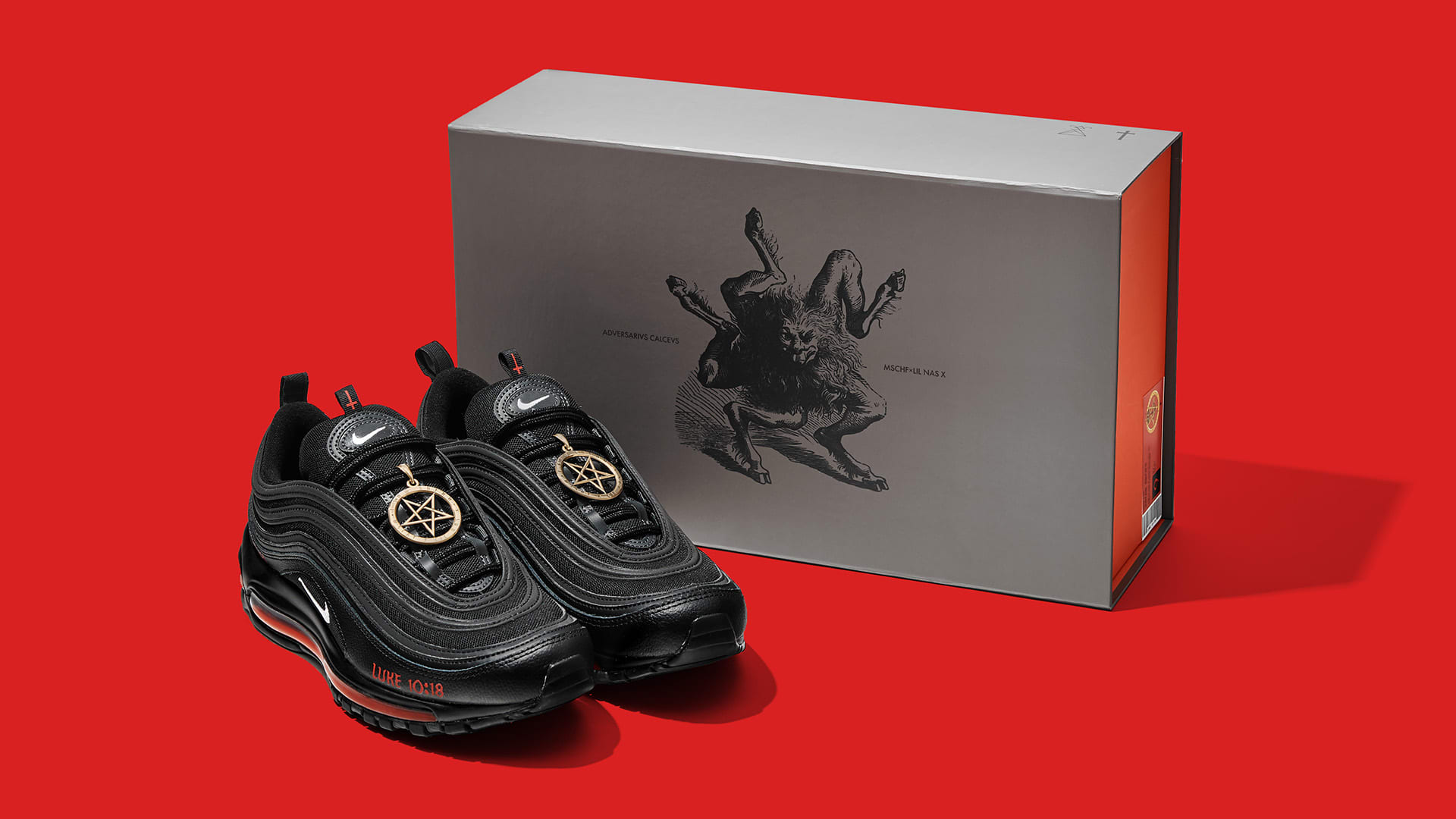
So a lot of it is about not restricting our outputs by putting all the variables under our control so that no third-party force can shut down a project for us. And as we got into that, shoes occupied this singular cultural place as objects across luxury streetwear, reselling focus, collector focus, all these things coalesce in the object of shoes.
There’s just a ton of meat there for us to explore and play with, and I think that we’re only even just scratching the surface of how far we can push that to whatever logical conclusion that that space might reach.
In doing that, did you have to have anybody who had experience in really designing a sneaker, or it’s just the same people who work on the other MSCHF projects?
So it’s a bit of both, right? My background is design, but not of shoes, and so we’ve brought in people who have experience on the technical construction of shoes who can draw up a spec that a factory is easily going to be able to interpret. And we’re working with factories that produce shoes, people who are from this industry. On the other hand, a lot of the shoes, I mean, you’ve seen the shoes.
A lot of the shoes that we are trying to make are not necessarily things that you know how to make even if you do have experience in sneakers. Honestly, a lot of what we do, just where every single thing we do is completely different and we start from the ground up, in some ways we’re almost better primed than some of these sneaker industry folks to tackle things. It’s just simply not a thing that you have experienced making no matter how many shoes you’ve made.
Would you say then that you not necessarily being sneaker industry people is an advantage or a disadvantage in these things?
I would classify it as an advantage. Again, I think for us, when you are in the sneaker industry you start to think in this very small box, right? It’s like, “Here are the things you’re allowed to play with.” Very basic soles and uppers, very basic colors, very basic laces, right? And we started by throwing that out the door and we’re just like, “If it can be on your foot, what does that even mean?” And we went from there. And I think when you have people that are so in the industry, they look at some of the stuff and they’re just like, “You can’t do this.” And we’re like, “Why not? Why can’t we do this? Tell us why we can’t.” And they can never come up with actual reasons, they’re just like, “What do you mean, why? This just isn’t how a shoe is made.” We’re like, “But who said that? We can do whatever we want.”
And I think what’s really interesting for us is we’re starting from the ground up. You might have Kevin or our other creative lead, Lukas, just hop into a sketchbook and start drawing something and it doesn’t even look like a sneaker, but then we take it to a factory and we’re like, “How do we make this real?” So a lot of the stuff that we’re doing, it’s stuff that people who just normally design sneakers wouldn’t even think about or understand fully.
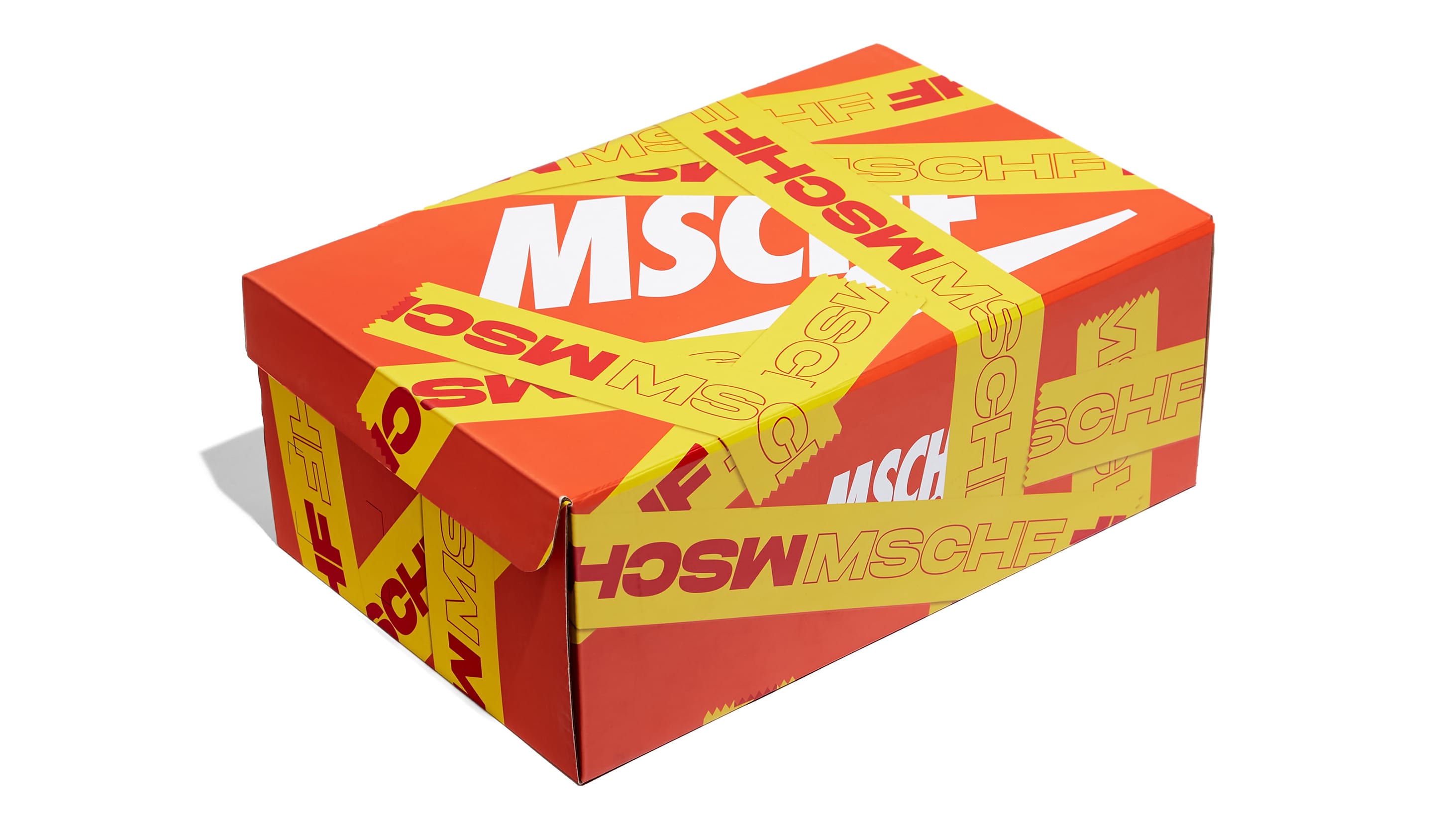
What are some of those things that are really hard to do that might boggle the mind of a conventional sneaker person?
It’s even basic stuff like the fact that, going into this, we just assumed that we would open a mold for every shoe we made, and make a new sole for every shoe we make. And anyone who comes from a company that has a sneaker line is just horrified by this concept.
Extremely expensive, right?
Yeah and just inefficient, but so much cooler. And I don’t know, who knows, maybe someday we’ll figure out a way to repurpose the mold that we made for the walking boot ankle cast into something else, but we’re just so accustomed to making singular objects that our heads weren’t even in the same space as anybody else. If you’ve seen the forward-backwards shoe, the backwards shoe just caused factories to have meltdowns because it assumes that you can make the toe look like the ankle of a normal shoe, and that’s not what shoe lasts look like. You can’t use a shoe last to get that shape. And we just were like, “Well, obviously you’re just going to mill a different last shape.” And people went bananas.
It’s clear to me that the people who work regularly at MSCHF are not sneaker industry people and that’s part of this project. Do you consider yourselves sneaker people on any level? Because to me, sometimes, it’s hard to discern whether the work is turning sneakerheads into the punchline or inviting them in on the joke.
You could say it’s a bit of both. We’re about probably 30, 35 people now that work at MSCHF, and I’d say we have people that work here that are huge sneakerheads. We have other people that couldn’t give a flying fuck about it, and really don’t care about the sneaker space at all. And I think that’s what makes it interesting, because you have different things that appeal to different people.
And what gets really interesting is that the stuff we’re trying to make isn’t just meant to appeal to a sneakerhead. It’s supposed to also appeal to people that are into art, internet culture, luxury fashion, even just basic streetwear, design, furniture. All these different things. We want to tap into all these different people. It’s not like we’re trying to make something that we’re making a business for “sneakerheads” that live on Reddit and Discord and StockX and GOAT, and they have their bots and they’re trying to buy everything.
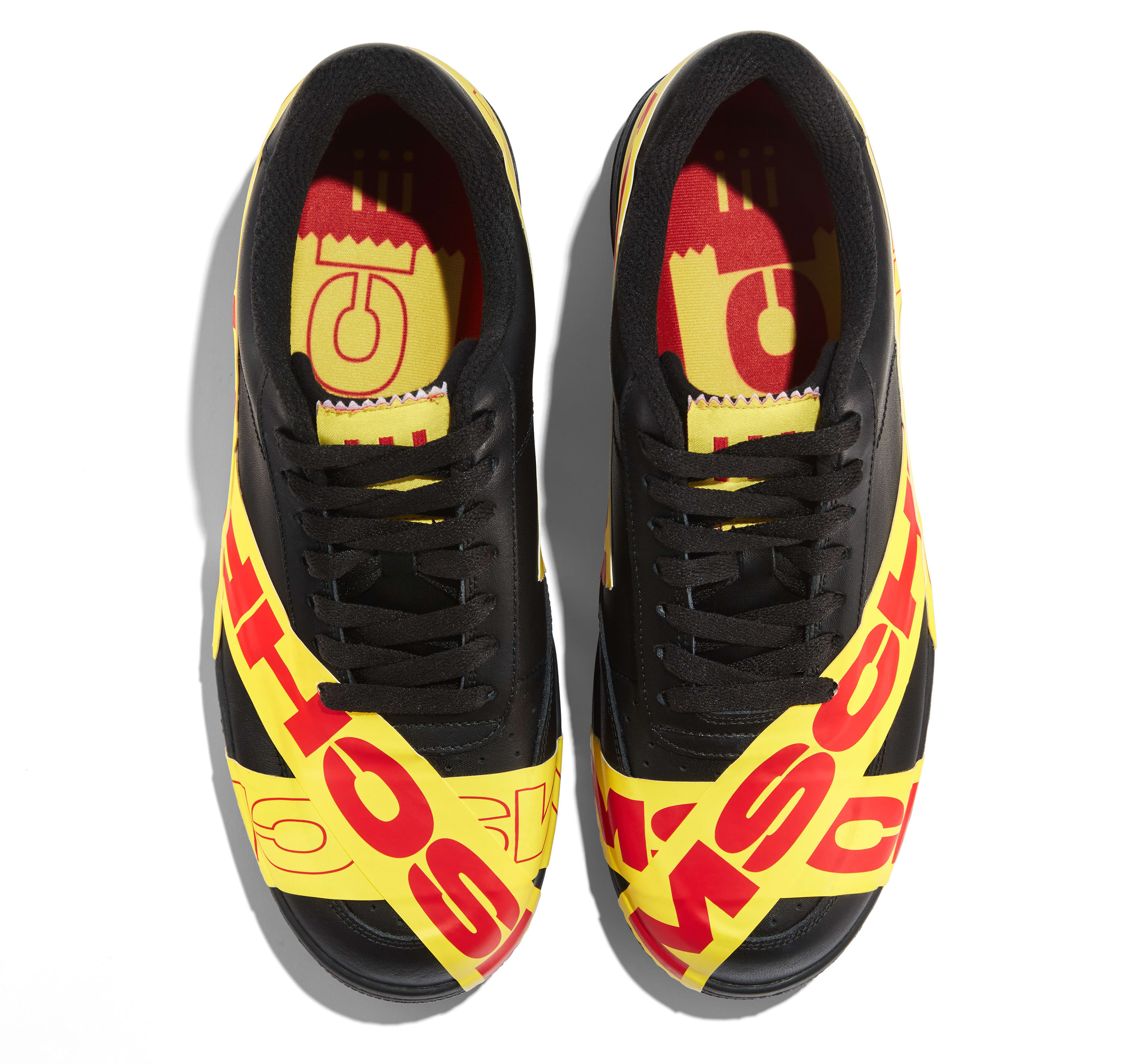
Those people will definitely be there, but that’s not who we’re trying to go after. We want everyone and anyone. I think again, when you talk about the punchline, it’s interesting when you do a sneaker. We talked about this, but we’re going to have the MSCHF Sneakers app and it’s basically a sneakers app. And then you have something come out of that app as a distribution channel that to the base of that app does not look like a normal sneaker that they would’ve ever seen. Whether that be a boot or potentially a high heel or a sandal. Who knows, but in their mind they are expecting, “Oh, this is the MSCHF Sneakers app. I’m going to be getting sneakers.” And then when they get some other piece of footwear that doesn’t really compute in their mind of, “Wait, this is what I was expecting.”
I think that’s really good for us. With all of MSCHF, right, whether it be our art, our drops, fashion, food, we always talked about how we want to engage in the space and not just observe it, so this is our way of just diving head into the entire, I’d say, landscape.
I’m interested to see how real sneaker people receive it, too. Because a lot of the previous work, it’s been mainstream or viral in a way, but also I feel like sneaker people have paid close attention to it.
Yeah, for sure. Again, for us, your guess is as good as ours as how they’re going to feel about it. I think that’s the really interesting part. You might have people that have been die-hard Yeezy fans for half a decade, and now they start seeing these sneakers and they’re like, “Wait, this is so much cooler.” You might have other people being like, “Nah, just stick with the basic Air Force 1 and the colorways and SB Dunks.” I think everyone’s going to have a different view and I think some people might love it, some people might hate it, and I think that’s going to be a really interesting thing to see how people react to the whole program.
It’s the hardest spot to convince people from though since you’re making your own models. How much harder is that production-wise?
I would say it’s definitely harder in the sense that anytime you’re making a shoe from scratch, it’s hard, and then add to that when you’re doing molds and shapes and designs that have never even been seen by anyone. And then take that onto an incredible, fast timeline that we put ourselves on. And then again, add to all of that we’re still MSCHF, we’re still doing our drops on Mondays, we still have all of that. We’re basically doing all of that together, and I think for us, it’s a good challenge but it’s definitely something that we’ve accomplished. It’s an incredible feat to be able to make your own high-quality sneakers in a year that are going to be coming out month over month in different molds and models and all that stuff.
Were there significant setbacks in terms of the timeline?
Obviously the global supply chain has been pretty screwy for everyone. So we’ve had stuff on boats that have been a little worse for wear, and obviously with COVID in the past year, different stuff. We’ve had the same logistical production setbacks that you hear from everyone else, and we’ve just pushed through and done the best we can. Again, we are hitting our timeline. This was meant to go live in March. The Satan Shoe was last year, March. A year was the plan, so it wasn’t like there had been any mega delays, but it’s definitely been some ups and downs and some close timelines.

Why did you feel like the Tap3 was the right one to introduce this project?
There’s a few pieces to this one. It’s one year to the week, if not exactly the day, of the Satan Shoes launch, and so with Tap3, essentially, we are starting from… obviously it’s different paneling, different construction, different soles, all of this, but the general platonic ideal of an Air Force 1, which is the shoe that is kinda everybody’s go-to. Every streetwear brand that decides to start getting into shoes, the first thing they do is they knock off an Air Force 1 and put their branding in place of the Swoosh, right? There’s a million different brands that have done this. And I do think that for a lot of people, if you close your eyes and you imagine like, “OK, what does a low-top sneaker look like?” A lot of people will basically come up with the silhouette of an Air Force 1. That’s a Nike shoe.
And so for us to take that general idea of a shoe and then slap our tape over all the places where branding typically goes on that shoe is, I would say, maybe subconsciously us working through a little bit of pent up aggression towards Nike that has accumulated. But I also think that, in some ways, we’re easing people into this by starting with our takeover of what I do think is one of the idealized forms of sneaker. And from there, then we ramp up into the really crazy stuff.
Have y’all paid attention pretty closely to the other lawsuits around this type of stuff? Whether it’s Warren Lotas or John Geiger.
Yeah, definitely. We follow it incredibly closely, yeah.
Do you have any take on the defense that this is Nike trying to stifle independent creators who are basing their works off of known Nike objects? Or do you have any feelings on that?
We’re not lawyers. Since we’ve done the Satan Shoes we’ve hired a very kick-ass general counsel that is quite well experienced. So I would say with the Tap3 shoe, we’ve done everything right. There’s no knockoff component, there’s no infringement. This is actually totally above the board.
I think in terms of everything that’s going on with Nike right now, I can speak personally that we are, as small artists, probably in favor of what someone like a John Geiger is doing. And I’d say, obviously we’ve been on the end where we were getting sued. Also for us what was so interesting is we weren’t even doing our take on their shoe, we actually just bought their shoe and modded it. So I’d say people like Warren Lotas, Geiger, they’re going even further. But I think in terms of that, it’s going to be really interesting how it plays out.
We all follow it closely, but I think it’s great that [Geiger is] taking the fight to them and hopefully he’ll come out on top.
When we did the Satan Shoes we were probably a company of 12 people, maybe. Nike suing us, in their minds, of course it’s nothing for them. But again, it’s this ability—this is just with any big company—but they can just dole out lawsuits left and right without blinking an eye and they do it on these small companies, or even individuals, that don’t have lawyers or have anything and they’re like, “Oh, fuck. What am I going to do?”
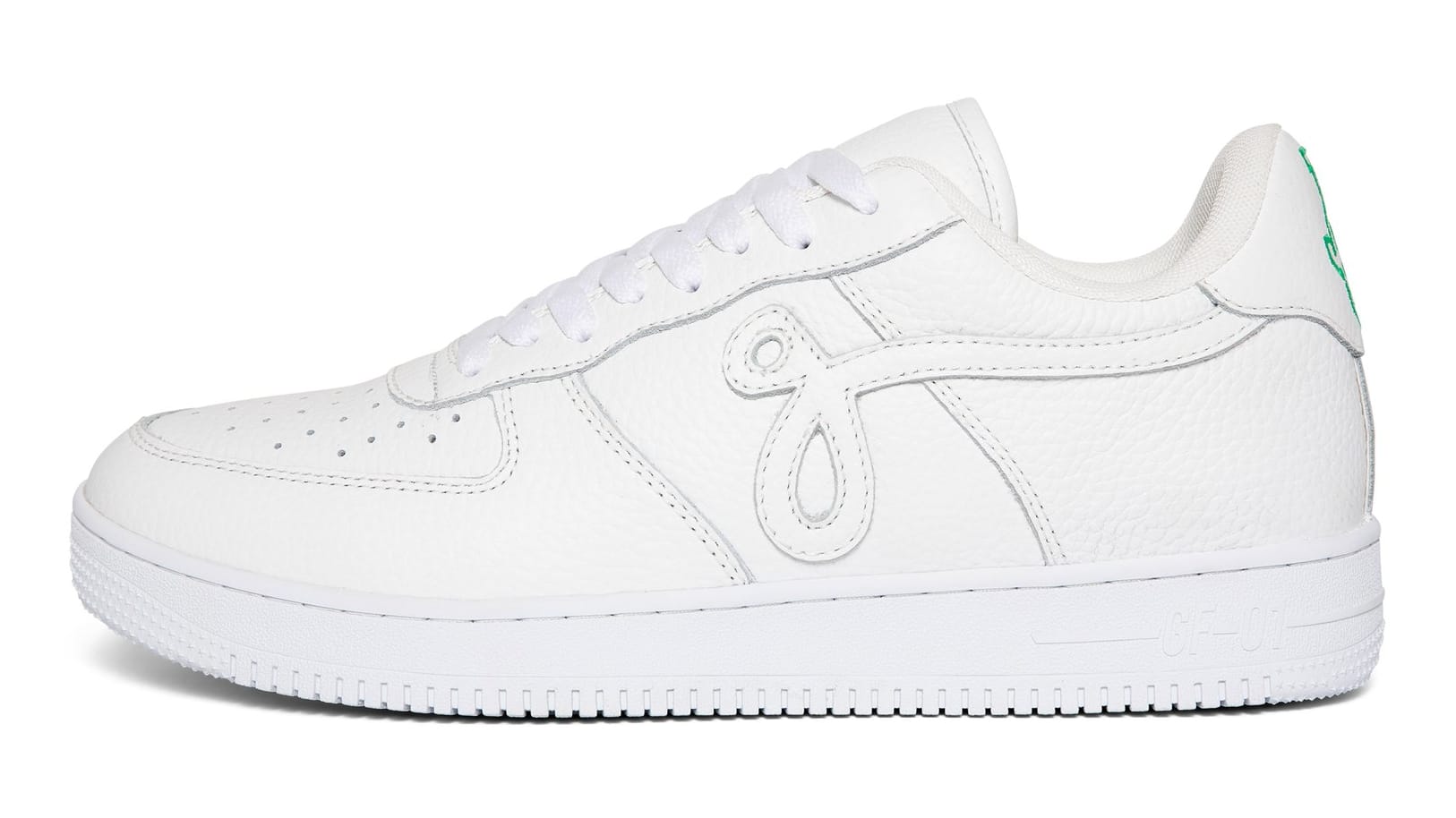
Is there more consulting legal-wise from your internal team that goes into a shoe like this now versus what would’ve happened prior to the Satan Shoe episode? Do you feel more certain? Because we actually spoke before the Satan Shoes came out and you felt like it was 1,000 percent safe and then the lawsuit came after that.
So we had a general council start probably four months ago. Something like that. Three, four months ago. Really experienced guy, worked with Obama for about two decades and then Ruth Bader Ginsburg for about a decade and now made his way to little old MSCHF in Brooklyn.
So he helps us make sure that what we’re doing while we’re still poking bears, always making sure we’re doing it completely defensible. I can’t stop anyone from suing anyone in this country. I can’t stop Nike from seeing the Tap3 shoe and saying, “We want to sue you.” But legally speaking from our general counsel, everything is done right here that if they were to sue, there would be no case here for them.
There is, again to put on record, no knockoff of Air Force 1. We didn’t use any of their stuff and warped it: fully original sole, fully original insole, midsole, upper, laces, all of it is our own shoe. And if Nike wants to say a black shoe is theirs, then so be it.
Is there any world in which MSCHF wants to work with big brands like Nike or Adidas or Vans, or that’s really outside of the aim of your work?
I think it depends on the brand and the idea. Nike in particular is a very specific one that has sued us, but if you want to talk about an Adidas or a Reebok or New Balance, I think it just depends on the concept and how we would do it. I don’t think we’re opposed to it, but it all comes down to the concept. If someone came to us and just said, “Do a colorway of our existing shoe,” that would be out of the question. That we are definitely not interested in. Now, if you’re coming to us and you’re like, “Hey, MSCHF, we want to give you carte blanche to do whatever the hell you want with our thing.”
Then let’s talk, right? I don’t know where that will go, but I’m happy to have that conversation. So I think it just depends on if there’s a collaboration, for lack of a better word, we’re going to be opening a new tool. I’m just being real. If they’re coming to us, we’re going to be changing the form factor or the shape of their shoe, or doing something completely new.
How limited is the stuff going to be on MSCHF Sneakers? Is this going to invoke some of the same rage as the Nike SNKRS app?
A couple months back I found this Nike SNKRS stock Twitter account that basically let you know the stock on every drop. And they were usually between like, 4,000, 7,000 8,500, 6,000, 10,000, in that range. I’ll say we’ll be in that range. I would say we’re not making dozens or hundreds of pairs. We’re also not making 50,000, 100,00 pairs. You know the space much better than I do, but at least based on what we were anecdotally finding on what limited releases are on Twitter, we think we’re playing in that normal range. So in the thousands, 2,000, 3,000, 5,000, 7,000.
Every shoe is completely different. Again, we’re not here making one-offs, we’re not here making one-of-one, 10-of-10. But it’s also not fucking Yeezy if they’re making a quarter-million pairs. We’re not doing that.
How do you arrive at those numbers? A lot of companies and brands don’t ever want to disclose exactly how many pairs they make because it’s an important balance for them of supply and demand. What’s your response to that?
I think for us, we just make whatever we feel is right. MSCHF has never done, for our drops, user testing or research, all of that stuff, we just make what we feel good about. We could be doing a shoe and we can look at it and Kevin looks, and I can sit down and be like, “Hey, you know what? There should be 2,500 of these. That’s cool.” And we’ll do it. We can look at something else and be like, “There should be 3,200.” We just look at it and pick. I think the idea that we want to do is definitely always limited. They always sell out right away, they always resell, so it’s not like we’re going to see something and be like, “Oh, let’s make 50,000.”
You won’t be happy if something is just sitting on there and hasn’t sold out?
No, definitely not. I’d say, structurally, that’s not the model that we are going for where it’s an always on e-com side of sneakers or the retail play of a Foot Locker or something. It’s definitely “Hey, this is dropping.” It sells out, our hope is it sells out in seconds, which we expect. And then we move on to the next shoe. So that’s the structure of which we’re approaching it.
There’s not going to be an always-on base shoe that you can just go to MSCHFSneakers.com and buy the Tap3 shoe. You can go to Nike or Adidas’ site and always buy a pair of sneakers. We are not going to have that.

